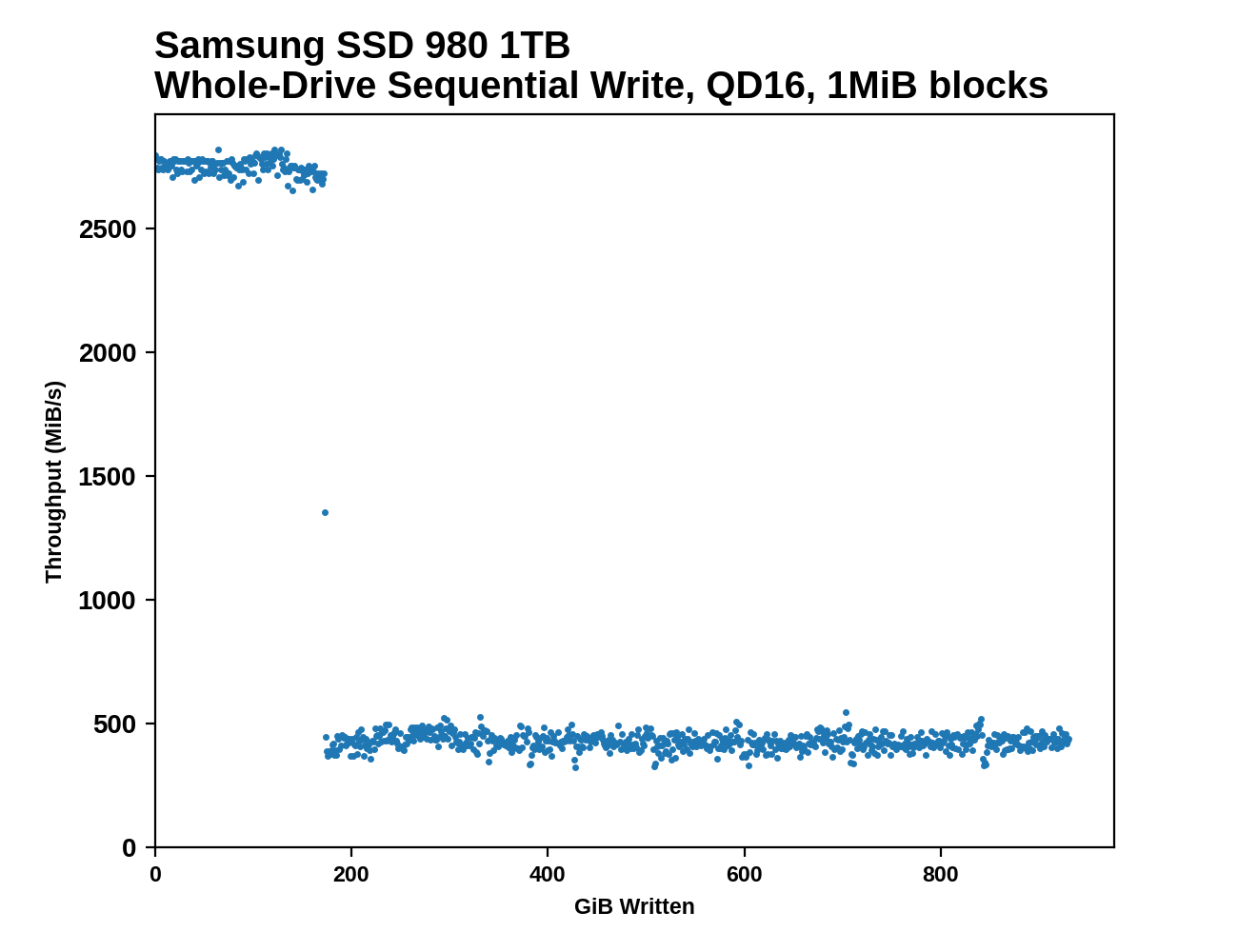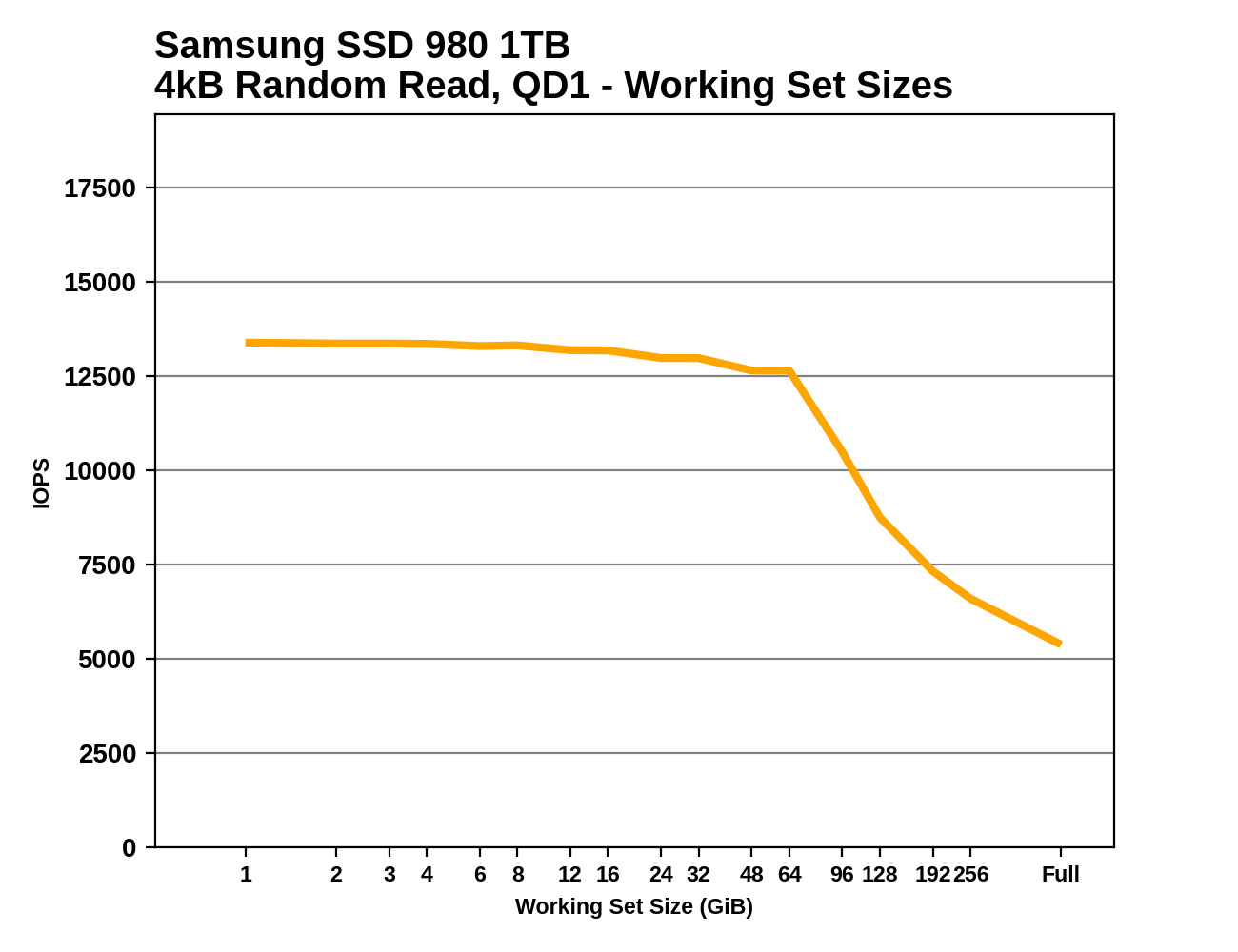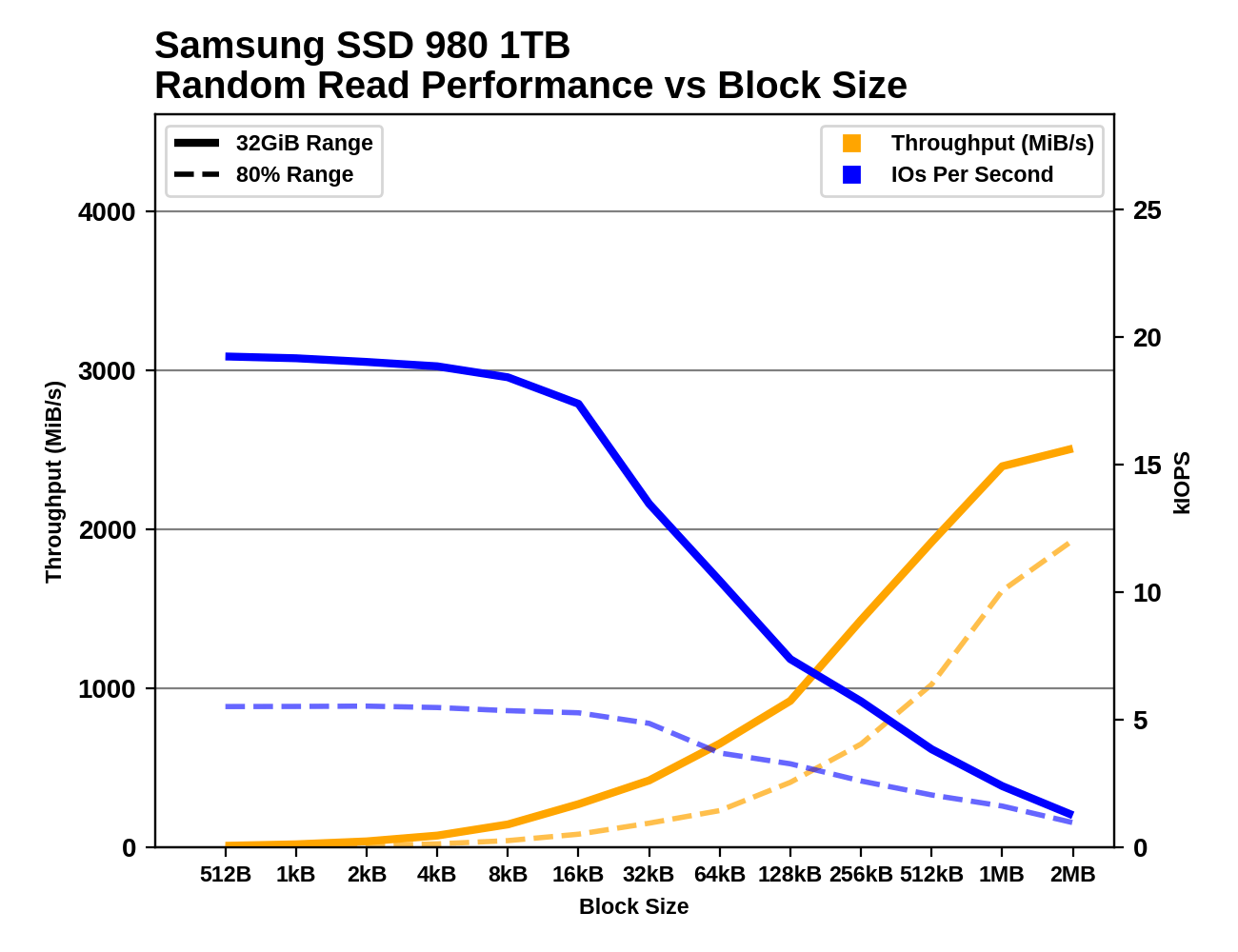The Samsung SSD 980 (500GB & 1TB) Review: Samsung's Entry NVMe
by Billy Tallis on March 9, 2021 10:00 AM ESTAdvanced Synthetic Tests
Our benchmark suite includes a variety of tests that are less about replicating any real-world IO patterns, and more about exposing the inner workings of a drive with narrowly-focused tests. Many of these tests will show exaggerated differences between drives, and for the most part that should not be taken as a sign that one drive will be drastically faster for real-world usage. These tests are about satisfying curiosity, and are not good measures of overall drive performance. For more details, please see the overview of our 2021 Consumer SSD Benchmark Suite.
Whole-Drive Fill
 |
|||||||||
| Pass 1 | |||||||||
| Pass 2 | |||||||||
The Samsung SSD 980 clearly has larger SLC caches than the 970 EVO Plus or 980 PRO, as advertised. But post-cache performance is about a third that of the 970 EVO Plus when comparing the 1TB models, and the 500GB 980 is even slower post-cache. The apparent cache sizes are about 100GB for the 500GB model and 173GB for the 1TB model: a bit larger than advertised for the 1TB and a bit smaller than advertised for the 500 GB. On the second pass of filling the drives, the 1TB 980 never gets back up to full SLC cache speed, and the 500GB model only does for about 5GB. Samsung didn't give specs for the minimum SLC cache size, but it's clear there's not much left when the 980 is full.
 |
|||||||||
| Average Throughput for last 16 GB | Overall Average Throughput | ||||||||
The 1TB SSD 980's performance on the whole-drive fill averages out to just a hair slower than the 1TB 870 EVO, and the 500GB model is about 25% slower than that. It's clear that both the narrower 4-channel controller and the lack of DRAM are both contributing to the lower write throughput of the SSD 980 as compared with Samsung's high-end NVMe drives.
Working Set Size
 |
|||||||||
The 64MB Host Memory Buffer used by the SSD 980 is very clearly illustrated by this test. Without HMB enabled, the 980's random read performance suffers even for small working set sizes of just a few GB, indicating there's very little on-controller RAM. For extremely large working set sizes, the 980's performance drops below the SATA 870 EVO.
The WD Blue SN550 shows slightly worse random read performance than the SSD 980 for smaller working set sizes, and its smaller HMB allocation means performance starts dropping sooner. But at large working set sizes or with HMB off, the SN550 retains more performance, and the SN550 seems to have more on-chip RAM for use when HMB is unavailable.
Performance vs Block Size
 |
|||||||||
| Random Read | |||||||||
| Random Write | |||||||||
| Sequential Read | |||||||||
| Sequential Write | |||||||||
The Samsung SSD 980 maintains high random read IOPS up to block sizes of 16kB, and throughput starts to saturate once the block size is up to about 1MB. For random writes, IOPS starts dropping after 4kB, or after just 2kB when the test is hitting 80% of the drive. With HMB off, the 980 shows a clear preference for 4kB block size for random writes. Sequential reads show odd behavior for block sizes from 32kB to 128kB, with performance stalling then regressing despite increased block size. This happens for both capacities, with or without HMB, so it's a systemic quirk—and an unfortunate one, since 128kB is the usual block size for sequential IO benchmarks. For sequential writes the SSD 980 is well-behaved with smooth scaling of throughput as block sizes increase. Neither capacity of the SSD 980 runs into SLC cache size limits during these tests.
By contrast, the WD Blue SN550 shows much stronger signs of optimization specifically for 4kB block sizes: the effect is small for random reads but huge for random or sequential writes. Sub-4kB accesses are a generally not worth the trouble on the SN550. This drive also appears to occasionally run out of SLC cache during the random write block size testing.










54 Comments
View All Comments
XacTactX - Wednesday, March 10, 2021 - link
Honestly I agree with you, the Hynix P31 is a top tier SSD and it costs $135 instead of $130 for this. A reasonable person should pay $5 extra. I also think the Phison E12 would be a nice alternative for ~$110, if only the manufacturers of all the E12 products would stop changing the flash memory and the controller every few months. I don't have faith in Adata, and I have only a little bit more confidence in Silicon Powerdsplover - Wednesday, March 10, 2021 - link
Right now “new” PCI 3.0 units are probably NOS. They’re all fast enough. This summer PCI 3 x 4 NVMe manufacturing will be competing to empty out old parts. Should be a great time for 2TB models for 149 USD.Billy Tallis - Thursday, March 11, 2021 - link
I really doubt Phison has stopped making new E12 controllers yet. They're still far too popular. Even E16 is still thriving as the cheaper gen4 option than E18 for use with QLC, and there are even some E16s going into gen3-only drives. Silicon Motion obviously can't stop manufacturing for the SM2262(EN) family until well after their new 8-channel controllers are shipping in volume; but they haven't hit the market yet.So I'd say it'll probably be at least another two years before a significant fraction of gen3 drives on the retail market are new-old-stock. These products aren't going away yet, and won't go away overnight.
mulamboi - Wednesday, April 21, 2021 - link
Does anyone already know how much samsung 980 pro 1tb to undermine 1 chia?Brazilian here o /